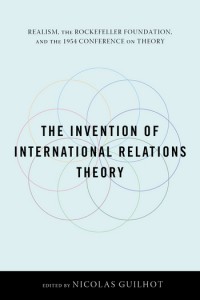Nicolas Guilhot, ed. (2011). The Invention of International Relations Theory: Realism, The Rockefeller Foundation, and the 1954 Conference on Theory. New York: Columbia University Press.
Review by Jessica Blatt
In May 1954, the Rockefeller Foundation (RF) brought together a group of scholars, foundation officials, and foreign-policy practitioners including Hans Morgenthau, Reinhold Niebuhr, Walter Lippmann, Arnold Wolfers, Dorothy Fosdick, and then-RF President Dean Rusk. As Rusk set it out, their task was to arrive at “basic philosophic aspects of the … theory of international politics” in order to do some “sorting out of intellectual factors in our foreign policy” (240).
In this, they failed miserably. As Nicolas Guilhot puts it in his introduction to The Invention of International Relations Theory, the transcript of this two-day conference reveals mostly “unfocused discussion, misunderstandings, equivocal notions, disagreements about fundamental concepts, and much soul searching that remains inconclusive down to the very end” (11). That participants were “realists” was clear, but the precise theoretical content of realism was not. However, the essays in this fascinating volume—all departing in some way from the conference—show that arriving at a theory, while it would have been nice, was only one of the conference’s goals.
The book reproduces the conference transcript in full, along with several papers that participants had prepared in advance. It pairs these with eight essays addressing the conference, its place in the disciplinary matrix of U.S. political scholarship at the time, and what it reveals about the subsequent development of IR. Of particular interest to S-USIH readers will be the book’s (and particularly Guilhot’s) focus on what Guilhot calls the “backstage logistics” of intellectual life: questions of funding, disciplinary “turf,” prestige relative to specific institutions, and the like. From this perspective, Guilhot and others present the 1954 conference largely as an attempt by a group of scholars, foreign policy practitioners, and foundation officers to resist the hegemony of behavioralism and scientism in American social science —or, failing that, to define IR as a separate enterprise and “realism” as its distinctive approach.
In his paper for the conference, Paul Nitze expresses “little patience with those behavioralist studies” and their “implicit rather than explicit” values” (279). Similarly, Reinhold Niebuhr complains that theoretical “laws in American culture tend to be too much like natural science laws” (252). Along with their sponsors in the Rockefeller foundation, particularly Kenneth Thompson, these scholars sought to advance a “realist” alternative, attentive to power, informed by wisdom, always partial, and grounded in “prudent self-interest” (Niebuhr, 271). (As Lippmann put it to Wolfers, the participant most sympathetic to behavioralism, “If you were a Guatemalan, you would construct a different political theory” [251].)
The push for realist theory was at once an intellectual and a political move. The emphasis on “value-neutral” science seemed to this group sterile and inadequate to the challenges of the postwar era. (Morgenthau on Harold Lasswell’s quantitative content analysis: “This kind of efficiency in the counting of words is useless if there is no theory behind it” [258].) But it also seemed too democratic—anyone can count words, after all. And as Anders Stephanson writes in his contribution to the volume, this crowd thought foreign policy should be decided by “an elite of general education capable of judging particularities far from the madding crowd and certainly far from the idiocies of domestic political culture” (171).
Three of the essays focus particularly on the antidemocratic thrust to realism. Stephanson’s contribution highlights realism’s emphasis on statesmanship and the morality of elites over scientific routinization or abstract rationality. For Philip Mirowski, this tendency is grounded in a “reactionary modernism,” counterintuitively shared by neoliberals like Hayek and realists like Morgenthau, in which a distrust of rationality underwrote a “double-truth doctrine—one for the masses, another for the elites” (271). For Inderjeet Parmar this celebration of “judgment” and rejection of universals rendered realism a good fit for “an elite ‘project,’ however ‘messy’ in practice, for U.S. global hegemony” (185).
Other essays explore the process of discipline formation. S-USIH readers will not be surprised to discover that Morgenthau, Thompson, and allies were unsuccessful in turning the tide against liberal scientism in the American academy. Instead, this volume shows, realists triumphed briefly. But the price, in Mirowski’s words, was that realism was “quarantined to a delimited sphere of international politics” (231, emphasis original). It is in this sense that the 1954 conference represents the “invention” of international relations theory. By claiming, or perhaps settling for, the international as the space to be studied according to “realist” tenets, the claim is, this group “made” IR as we know it. (Part of this process, as essays by Brian Schmidt and Ole Wæver show, involved IR’s subsequent elaboration of a semi-mythic history for itself.)
Guilhot provocatively argues that “there is no such thing as IR theory, only an institutional decision to generate an autonomous disciplinary subspace inhabited by a specific group of scholars” (12). For him, the case of IR demonstrates that a “disciplinary landscape does not always need robust theoretical foundations in order to flourish… [I]ts development may be better explained by a range of external factors—institutional support, availability of funding, critical developments within adjacent fields, alliances with outside stakeholders such as policymakers or bureaucrats, and a wealth of other issues that are too often absent from conventional intellectual histories” (14).
All the same, as the conference organizers clearly perceived, theory does matter. While realists achieved a brief hegemony in the study of international politics, Guilhot points out that as early as the 1960s, scientism began to exert its “gravitational pull” on IR, in the form of rational choice methodologies. Contributions by Robert Jervis, Jack Snyder, Schmidt, and Wæver to differing degrees indicate that the lack of a positive theory, and the (mostly instrumental) lip service paid to “science” by the 1954 conference participants and their allies left IR vulnerable to the irredentism of mainstream U.S. social science. That is, the disciplinary space of IR persisted, but its architects lost control of its content and direction.
The volume does not aspire to be the last word on the origins of postwar IR. Indeed, the consistently thought-provoking contributions disagree on several points. More importantly, by making the conference transcript and papers available outside the walls of the Rockefeller Archive Center in Tarrytown, New York, the volume invites readers to test the essays against (some of) their sources and generally opens the subject for further work. Given the stature of the conference participants, and the breathtaking range of events in which they were influential, this by itself is noteworthy. And while some of the essays will be of more interest to scholars outside of political science than others, the volume as a whole is a must-read for historians of social science and has a great deal to offer anyone interested in twentieth century U.S. intellectual history.
 Jessica Blatt is an Assistant Professor of Political Science at Marymount Manhattan College. She is at work on a history of the idea of racial difference in U.S. political science.
Jessica Blatt is an Assistant Professor of Political Science at Marymount Manhattan College. She is at work on a history of the idea of racial difference in U.S. political science.

5 Thoughts on this Post
S-USIH Comment Policy
We ask that those who participate in the discussions generated in the Comments section do so with the same decorum as they would in any other academic setting or context. Since the USIH bloggers write under our real names, we would prefer that our commenters also identify themselves by their real name. As our primary goal is to stimulate and engage in fruitful and productive discussion, ad hominem attacks (personal or professional), unnecessary insults, and/or mean-spiritedness have no place in the USIH Blog’s Comments section. Therefore, we reserve the right to remove any comments that contain any of the above and/or are not intended to further the discussion of the topic of the post. We welcome suggestions for corrections to any of our posts. As the official blog of the Society of US Intellectual History, we hope to foster a diverse community of scholars and readers who engage with one another in discussions of US intellectual history, broadly understood.
No George Kennan, who was required reading in my foreign affairs course in 1962:
“These celebrated lectures, delivered at the University of Chicago in 1950, were for many years the most widely read account of American diplomacy in the first half of the twentieth century.”—Foreign Affairs, Significant Books of the Last 75 Years
Bill — Kennan is discussed in the volume; the Stephanson essay is largely devoted to him. But he wasn’t at the meeting and wasn’t an active participant in the process of academic discipline/theory building, at least according to the account this volume provides.
An informative review, thank you. I may come back later if I have something more substantive to say. (I note that Guilhot’s own argument is in a 2008 essay in the journal Int’l Political Sociology, which I think is reprinted, perhaps w a bit of tweaking, in this volume, though I haven’t read the book.)
As for Bill Harshaw’s remark about Kennan: I suspect one reason he wasn’t involved in this conference is that he was not that interested in these theoretical or meta-theoretical exercises. He was probably asked and declined to participate, though that is a pure guess on my part, I really have no idea. Since every millisecond of Kennan’s life has been the subject of about ten doctoral dissertations apiece (yes, slight exaggeration), I’m sure the precise answer is out there in the record somewhere.
I was wondering if there was much discussion of interdisciplinarity in the book. I’ve found in my own research that political scientists were some of the most violently opposed to interdisciplinarity, while IR specialists seemed to embrace it. I could see this group of intellectuals going either way – interdisciplinarity would be an affront to their elitism, but at the same time it could be an antidote to scientism in the IR realm.
Matthew– in the early-to-mid twentieth century, interdisciplinary work was one of the hallmarks of the scientistic approach, and of behavioralism which took much of its inspiration from psychology, sociology, anthropology, and even biology. The search for “a theory” was connected to the hope of resisting these tendencies. Of course, what counts as in and outside of a given discipline is precisely what it being contested/constructed in the story this book tells.